You are using an out of date browser. It may not display this or other websites correctly.
You should upgrade or use an alternative browser.
You should upgrade or use an alternative browser.
Alton Towers, Sir Francis Bacon and the Rosicrucians
- Thread starter MJF
- Start date
I have mentioned before in another post that some of the US Revolutionary leaders had approached Prince Charles Edward Stuart (Charles II's great nephew) to see if he would assume the throne of America in place of George III.
Not sure if it helps or hinders, but there was also talk of forming the Kingdom of Australia and putting a prince on the throne here.
Adelaide Observer, 1863
Launceston Examiner, 1867 - this article also mentions that there was similar talk in Canada.
Sydney Evening News, 1897
It seems that the major reason against having a reigning monarch was that the population wasn't big enough or wealthy enough to support a monarchy. Additionally, and I can't remember where I read it, apparently none of the princes that were proposed to take the throne here wanted to live here.
Last edited:
I think that the Talbot family are a key to this since they link many things together. Ineed, I have just found that they also link with the Percy family.Problem is that here, you are mostly dealing with red herrings, human groups that don't even know they are diversions and dupes.
I think you need to spread your net wider and start getting into deep history.
Just to repeat the C's quote that got us into this:
Q: Now, I notice that the Celtic name for the town of St. Albans is Verulamium, and that is where Henry Percy, son of Hotspur, was killed in battle. I also notice that Sir Francis Bacon was Lord Verulam, and he was thought to be not only a Rosicrucian, but also the author of the Shakespearean plays, as well as some of the Rosicrucian manifestos...
A: Check out Alton Towers, for clues.
In your statement you said that Hotspur died at St Albans in Hertfordshire. I am not sure of your source for that but my understanding is that he died at the Battle of Shrewsbury in 1403. See Henry Percy (Hotspur) - Wikipedia
So why mention Alton Towers (Castle)? Because that was one of the seats of the Talbots, the Earls of Shrewsbury. I have now found that there is an important link between the Percy family and the Talbot family through Henry Percy 6th Earl of Northumberland.
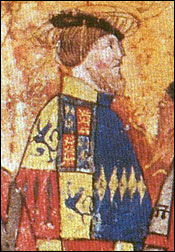
Henry Percy, 6th Earl of Northumberland - Wikipedia
As you can see, he was the lover of Anne Boleyn but was forced to marry Lady Mary Talbot, daughter of the Earl of Shrewsbury, by early 1524 or in 1525. They had no children though.
However, did Henry Percy father a child by Anne Boleyn that has been hidden from history?
That odd mention of Trent by the C's reminds me that the river Trent rises in Staffordshire where Alton Towers is located and flows out to the sea at the Humber Estuary in Yorkshire. You will also note that Henry Percy was created Lord President of the Council of the North. Makes me wonder about the 'Holder of the Trent' reference and if there is a connection.
Apart from the Talbot family, I think much of what the C's said in these sessions seemed to focus on Sir Francis Bacon, a key man in world history for so many reasons, but particularly I think for his involvement in the creation of the English American colonies with Sir Walter Raleigh and others. I have more information to post that may also make sense of the C's reference to 'Lodestar' (a guiding star). I am also using Bacon's title as Lord Alban to make other historic connections that go deep into ancient history. Please bear with me. Bacon rarely did anything without a purpose and that includes choosing his title.
Well, that's an interesting conjecture about Anne Boleyn.
I've got quite a few connections between my Percys and the Earls of Arundel in the tree, but I didn't find any Talbots except a couple more recent connections who spelled their name "Talbott".
It's all highly suggestive of something underneath, but no cigar yet.
I've got quite a few connections between my Percys and the Earls of Arundel in the tree, but I didn't find any Talbots except a couple more recent connections who spelled their name "Talbott".
It's all highly suggestive of something underneath, but no cigar yet.
Well I hope you find this posting a bit more meaty.Well, that's an interesting conjecture about Anne Boleyn.
I've got quite a few connections between my Percys and the Earls of Arundel in the tree, but I didn't find any Talbots except a couple more recent connections who spelled their name "Talbott".
It's all highly suggestive of something underneath, but no cigar yet.
You asked me to dig deeper into history and that is certainly what I have been doing these last couple of weeks. As you know, it can take time to dig out material and discern a pattern.
In the session dated 28 June 1997 the subject of St Albans came up again:
Q: Well, Cecil was the fellow who kidnapped me. And, when he was arrested, the Navy came and took him away saying he was "incompetent to stand trial" because he had "escaped from a Navy hospital." And that essentially ended any hope of finding out where I was taken or why. I just don't see. How does this relate to St. Augustine, the Canaries, to Oak Island - all of this? What are we doing here?
A: St. Albans.
Q: And there is more! My God! We aren't happy with Mary Magdalene and St. Augustine, and St. Anthony! Now we also have St. Albans! Of course I know that it is the place where there was a battle and one of the Percy's was killed there. It was also called Verulamian in the Celtic days, and Francis Bacon was Lord Verulam and some suspect that he was the son of Elizabeth I. But, there are only so many hours in the day, guys! I need some help here! I was hoping that I would be getting some help with the research...
I am going to attempt here to link Sir Francis Bacon with St Albans, Oak Island and the Canary Islands.
In my previous post, I mentioned Bacon’s choice of aristocratic title. Well he was born in Gorhambury, St Albans so that would seem to explain why he chose St Albans. However, is there more to the choice of the name ‘Albans’? Well according to Peter Dawkins, something of an expert on Bacon, there is. This is what he has to say on the subject:
The choice of Gorhambury, St Albans, by Sir Nicholas Bacon, as the place to build his family home and ‘mystery school’ country retreat shortly after Francis Bacon was born, was certainly not by chance. Not only is St Albans an important location on the ancient ‘Bran Route’ from Anglesey to London and home of the British martyr, Saint Alban, the founder of Freemasonry in Britain, but also St Albans lies within Ophiuchus, the Dragon Master or Serpent Bearer. Ophiuchus not only relates to Asclepius, the Greek god of medicine, and St George, the Christian Red (or Rosy) Cross Knight, but is known as the 13th Sign of the Zodiac. In the Arthurian myth, this is the 13th Seat of the Round Table, upon which the rightful heir to the throne sits.
I would also point out that Albion is the old British name for Great Britain and the old kingdom of Scotland was called Alban. In addition, Geoffrey of Monmouth in his ‘The History of the Kings of Britain’ mentions that after the Trojan War, Aeneas fled from the ruined city of Troy with his son Ascanius, he ended up in Italy and took over that kingdom (the Etruscans?). He was succeeded by his son Ascanius who Monmouth tells us founded the town of Alba on the banks of the river Tiber. This town would go on, of course, to become Rome. According to Monmouth, Ascanius’s son was Brutus, the first King of Britain (see my post on the giant Gogmagog in the thread for the session 13 March 2021).
Bacon had read Geoffrey on Monmouth and it is interesting that as Shakespeare (if indeed Bacon was the real Shakespeare or spear shaker) he would write a play that concerned Macbeth, a King of Alban and then King Lear a play about one of Brutus’s successors.
I also mentioned in my previous post that I might have an explanation for the C’s reference to ‘Lodestar’ in the session dated Session 14 August 2016:
Q: When I post material on the website, those people who resonate to the material
believe that this refers to them also. I have been of the opinion that Unified Thought
Form being must mean a very large group as represented in this density. I know that we
are dealing with limiting terms. But, is this applied to people who CHOOSE the
Cassiopaean option?
A: Maybe it is best to say it applies to those who recognize the application.
Q: So, if they recognize it, if they know it is them, they are part of it. (A) But, thinking
in nonlinear terms, it’s up to us to work to make this precise. You are asking this question
which implies that the answer exists. But, exactly what the answer is maybe it is not yet
chosen, and it is up to us to make it this way.
A: Lodestar is a clue for you.
Lodestar is a device that William Shakespeare used a lot in his plays. Take just one example from ‘A Midsummer Night's Dream’:
Lodestars: guiding stars
"Your eyes are loadstars, and your tongue's sweet air
More tuneable than lark to shepherd's ear."
—Helena (1.1.184–85)
In many ways you yourself are a lodestar to this Forum in the sense described by Shakespeare. However, assuming that Shakespeare is Bacon, then he used references to stars for numerous other purposes, as I will now demonstrate below.
In the same session with the C’s in which they referred for the first time to Alton Towers, you got involved in an exchange about new stars:
Q: Supposedly, Christian Rosencruetz was initiated by the 'philosophers of Dancar.' I want to know where this blasted place is! Okay, skip it. One of the Rosicrucian manifestos said: 'God has sent messengers and signs in the heavens, namely the new stars in Serpentarius and Cygnus, to show that a great council of the elect is to take place.' What do they mean by a 'great council of the elect?'
A: Pyrenees.
Q: Okay, the purported enclave of the alchemists... Why was it signified by new stars in Serpentarius and Cygnus? What do they represent?
A: Novae.
This theme also continued in this further exchange:
Q: In reading the Celtic legends, I discovered that Cassiopaea was equated with Danu, or Don, as in Tuatha de Danaan, or the court of the goddess Danu. So, in other words, the supreme goddess of the Aryans was Cassiopaea. And, Cassiopaea is found in the zodiacal area of Aries, the 'lamb,' where Cephus the 'rock' and 'king' is also found, as well as Perseus, 'he who breaks' and serpentarius. {Just noticed that the previous question about the supernova in Serpentarius could be a reference to the supernova in Cassiopeia by this grouping method.} The image is of Perseus overcoming the serpent, and the ancient Celtic engravings of the horned god show him gripping two serpents by the throat. I would like to understand the symbology here...
A: You are on the right track
I have already referred to Peter Dawson’s work and I would direct you to his brilliant website Sir Francis Bacon – Philosopher | Francis Bacon Research Trust Gateways to Wisdom, Francis Bacon Research Trust. I don’t think this website existed when you did your original research. I am taking the liberty of attaching two pdfs that he has made available on the site, which only date back to 2017. One is called The British Landscape Zodiac and the other is The Mystery of Oak Island - Part 3: Swan Secrets. I think what is contained in these articles is very revealing and helps to explain the C’s references.
It is worth also looking at Dawson’s webpage on Geocosmology FBRT | Geocosmology: the Hermetic Science and Art of Geomancy and Cosmology which he explains as follows:
The word ‘geocosmology’ was invented as a combination of two words, ‘geomancy’ and ‘cosmology’, and refers to the science and art of geomancy and cosmology and their interrelationship or interface.
“Geomancy literarily means ‘earth divination’ but is, fundamentally, a science of natural energy, form and consciousness in respect of the human being as well as of the planet with its landscape and man-made environment—and, by extension, of nature everywhere.
(Divination is the art of sensing, intuiting, perceiving and being inspired, which, when coupled with the rational faculty, culminates in understanding.)
Cosmology is a science concerning the natural or physical cosmos or universe, and the mind or consciousness behind it. At its highest level it is a science of wisdom and metaphysical truths, including that of the spiritual archetypes and intelligencies (angels) of the universe—in other words, a science of spiritual energy, form and consciousness”.
He goes on to say:
It is becoming increasingly clear that Francis Bacon and others associated with him had a good knowledge of the geocosmological energy pattern or zodiac of Britain—a pattern recognised before them by the Celts, Romans and Normans, all of whom utilised this knowledge. The particular siting of Gorhambury, Bacon’s country estate, within the zodiac of Britain, and the geometric or geocosmological pattern laid out and marked by him across its landscape after he had inherited the estate, bear witness to some of this knowledge.
Also significant in the Bacon-Shakespeare-Rosicrucian mystery are the relative locations of Stratford-upon-Avon and Gorhambury, St Albans, within the landscape zodiac of Britain in respect of the celestial phenomena associated with and leading up to 1604—a 3rd-magnitude nova in Cygnus that was first sighted in 1600, unusual planetary conjunctions during 1603-4 and a 1st-magnitude supernova in Ophiuchus in 1604, the latter of which marked the metaphorical opening of the Rosicrucian tomb of Fra CRC and the start of making public the Rosicrucian work that had hitherto been prepared in secret. The “new stars” in Cygnus and Ophiuchus are especially noted in the symbolic illustration depicting the Invisible College of the Rosicrucian Fraternity in Theophilus Schweighardt’s book, Speculum Sophicum Rhodo-stauroticum, published in 1618.
The choice of Gorhambury, St Albans, by Sir Nicholas Bacon, as the place to build his family home and ‘mystery school’ country retreat shortly after Francis Bacon was born, was certainly not by chance. Not only is St Albans an important location on the ancient ‘Bran Route’ from Anglesey to London and home of the British martyr, Saint Alban, the founder of Freemasonry in Britain, but also St Albans lies within Ophiuchus, the Dragon Master or Serpent Bearer. Ophiuchus not only relates to Asclepius, the Greek god of medicine, and St George, the Christian Red (or Rosy) Cross Knight, but is known as the 13th Sign of the Zodiac. In the Arthurian myth, this is the 13th Seat of the Round Table, upon which the rightful heir to the throne sits.
Then there is the much bigger scale of geocosmology—the planetary scale used by the Rosicrucian fraternity and Francis Bacon in which Britain lies within Cassiopeia, the Heavenly Virgin Queen, and Cygnus is associated with Nova Scotia and the mystery of Oak Island. Using Rosicrucian terms, Bacon refers specifically to "navigation" (a Rosicrucian is a "navigator") and to the use of the "compass". This refers primarily to navigating the world of thought and creating in the human understanding "a holy temple after the model of the world”, but it also refers to the navigation of the world in which the magnetic compass and compass rose is used.
Hence, we now get an explanation for the importance of Cassiopeia to the ancient Britons and in particular the Druids and a reference to the supernovae mentioned by the C’s. Now I am no expert on Rosicrucianism but Dawson does use their teachings, literary works and mythology to explain what lay behind their doctrines. It also sheds light on matters addressed in the plays of Shakespeare. If anything I have touched on here is old hat to you and the Forum then I apologise as I have not read all of your works.
For further reading on the subject, Dawson also makes reference to the Shakespeare-Bacon essays of Matthew Walker. See website here The Shakespeare-Bacon Essays of Mather Walker
Unfortunately, I could only access Part 3 of the Oak Island Mystery paper on the website but it does look very interesting and may appeal especially to those who may have followed your own research and those who have watched the ongoing TV series ‘The Curse of Oak Island’ The Curse of Oak Island - Wikipedia
The article is quite long and rambling but establishes, I believe, a reason why Bacon might have been involved with Oak Island given what the C’s have added about the alchemists alcove in the Pyrenees, which Bacon would almost surely have known about and probably been in contact with, given his high position at court, his seniority in the Rosicrucian Fraternity and his control over England’s spy network. The fact is the article links St. Albans, Oak Island and the Canary Islands together and I have never seen that elsewhere. It would also seem that Deneb is the lodestar here.
At some stage did Bacon organise an expedition to Oak Island? If so, he seems to have kept it off the books as there appears to be no record of it.
BTW The deliberate laying out of towns and cities in accordance with celestial constellations is something which has been seen also in Central and North America. I have watched Ancient Aliens episodes where they demonstrated the Mayans did this and the Native American Indian tribe, the Anasazi, who built Chaco Canyon and other pueblo towns in the state of New Mexico. And then, of course, there is the Giza Plateau. Was this a knowledge inherited from Atlantis I wonder?
I hope to shed some light by means of a further post on that strange statement the C’s made about ‘Spawn of the Dragon’, assuming you have not resolved that cryptic statement already. I also have further insights to share on Bacon and his New Atlantis and on the Hyperboreans.
Attachments
Last edited:
Well don't forget that Henry Percy and Mary Talbot had no children.Well, that's an interesting conjecture about Anne Boleyn.
I've got quite a few connections between my Percys and the Earls of Arundel in the tree, but I didn't find any Talbots except a couple more recent connections who spelled their name "Talbott".
It's all highly suggestive of something underneath, but no cigar yet.
Thanks for your comments. I think Australia is more likely to become a republic these days. However, it shows some forward planning on the part of the UK government and the nascent governments of the Australian states at that time. Given its modern cities and developed social scene and culture today, would a modern royal jump at the chance? You only have to see Prince Harry decamping to California (under particular circumstances of course) to see that it could happen. What do you think of King Andrew of Australia? Joking aside, I recall that Tony Robinson (Baldrick in Black Adder) tracked down the rightful Plantagenet claimant to the throne in Western Australia a few years ago. Hence, it looks as though you already have a ready made candidate.Not sure if it helps or hinders, but there was also talk of forming the Kingdom of Australia and putting a prince on the throne here.
Adelaide Observer, 1863
Launceston Examiner, 1867 - this article also mentions that there was similar talk in Canada.
Sydney Evening News, 1897
It seems that the major reason against having a reigning monarch was that the population wasn't big enough or wealthy enough to support a monarchy. Additionally, and I can't remember where I read it, apparently none of the princes that were proposed to take the throne here wanted to live here.
In the course of updating my google earth placemarks concerning "locations with occult significance", I noticed that St Albans and the Camberley Obelisk have pretty much the same distance from West Wycombe:
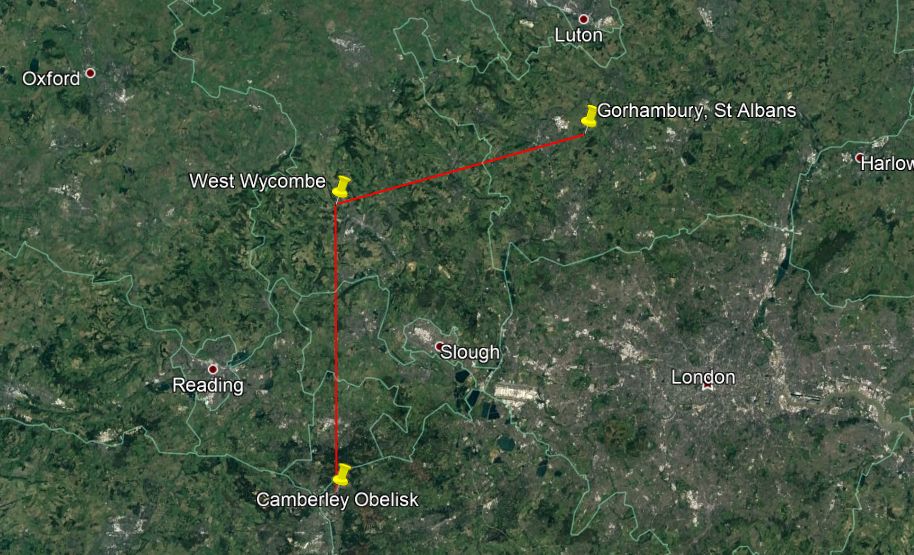
Could this have some importance for our topic? I don't know.
But ... we have this thing with communication via "kites".
Now read the first post in this thread from another forum here:
https://stolenhistory.net/threads/d...e-club-obelisks-and-masons-007’s-legacy.1621/
The intersting part is when it goes about The Golden Globe atop St Lawrence's Church:

Could this have some importance for our topic? I don't know.
But ... we have this thing with communication via "kites".
Now read the first post in this thread from another forum here:
https://stolenhistory.net/threads/d...e-club-obelisks-and-masons-007’s-legacy.1621/
The intersting part is when it goes about The Golden Globe atop St Lawrence's Church:
...
The most interesting tale relating to the ball claims that Dashwood was somehow communicating with a tower, now known as the Camberley Obelisk, near Hawley, Hampshire, 21 miles (34 km) to the south. It’s claimed that the tower was built about 1765–1770 by Dashwood’s friend, John Norris, who was a prosperous merchant, a member of the landed gentry and of course, the Hellfire Club. The tower is situated on top of a hill, about 2 miles (3.2 km) east of Norris' house. At the time of its construction the town of Camberley had not yet been founded and the area was open heathland.
The theory goes that the two men signalled to each other from the top of the two towers, either using flags or heliographs.
Last edited:
Also from this thread:
Dee was Elizabeth I’s Spymaster, as he had a ‘network’ of occult contacts all over the world. In his secret communications with the Queen he always signed himself 007 – and that’s not a joke. He was a real whizz with ciphers and codes. Edward Kelley was his medium, he was a less politically oriented chap some 30 years younger than Dee. Kelley, who had a history of fraud and forgery also had several aliases – when he first went to Dee’s house he was calling himself Edward Talbot. ...
Last edited:
I seem to recall in your discourse with the C's you were following a theory that Anne Boleyn had a child out of wedlock with Henry VIII. Did they not confirm that she did have another child but it was not with King Henry. If so, then it is likely that the child she had was sired by Henry Percy. As a Percy, this would make that child your kin.Well, that's an interesting conjecture about Anne Boleyn.
I've got quite a few connections between my Percys and the Earls of Arundel in the tree, but I didn't find any Talbots except a couple more recent connections who spelled their name "Talbott".
It's all highly suggestive of something underneath, but no cigar yet.
Also from this thread:
Thank you for the link to this thread on John Dee. I will read it with great interest. It is also very relevant to what I hope to post on Francis Bacon in the near future. It should be recalled that Francis Bacon was a young man at the Court of Queen Elizabeth I when Dr. John Dee was the Queen's favourite astrologer and magus. I think Dee was also something of a mentor to Bacon. Both men seemed to have an obsession with the New World and the nascent American colonies. I wonder if Dee, like Nostradamus, was shown images of the future and therefore appreciated what the United States of America would become in our own time. It is note worthy that Dee’s friend, the courtier-explorer Humphrey Gilbert, planned to establish an academy where alchemy would be one of the courses taught. Bacon also hoped to establish an academy of learning and this would eventually be realised in the Royal Society created several decades after his death. The great scientist Isaac Newton, who was one of its early presidents, was also a secret alchemist. Newton also carried out a large scale investigation of the mathematical knowledge encoded in the Great Pyramid at Giza.
I am reading additional material about Bacon that I hope will reveal more about his links with Dee and the esoteric knowledge they may have shared together. To get the bigger picture, you need to see the connections between various notable people of that time. Obviously, Dee and Bacon had links with the leading alchemists of that age in Europe, including those based in the Pyrenees presumably. Another major player in this hermetic movement was Giordano Bruno who travelled widely in Europe and came to England and may have met with Dee and his circle (see attached link for article). As a Dominican friar, he translated the Hermetica after it had been brought to Florence by the Byzantines. The Hermetica was supposedly the work of Hermes Trismegistus (Enoch - which explains Dee's interest in Enochian magic) who has been referred to in the transcripts. Bacon would also study the Hermetica and incorporate some aspects of it in his 'Great Work', which underlines what the Rosicrucians really espoused.
I am reading additional material about Bacon that I hope will reveal more about his links with Dee and the esoteric knowledge they may have shared together. To get the bigger picture, you need to see the connections between various notable people of that time. Obviously, Dee and Bacon had links with the leading alchemists of that age in Europe, including those based in the Pyrenees presumably. Another major player in this hermetic movement was Giordano Bruno who travelled widely in Europe and came to England and may have met with Dee and his circle (see attached link for article). As a Dominican friar, he translated the Hermetica after it had been brought to Florence by the Byzantines. The Hermetica was supposedly the work of Hermes Trismegistus (Enoch - which explains Dee's interest in Enochian magic) who has been referred to in the transcripts. Bacon would also study the Hermetica and incorporate some aspects of it in his 'Great Work', which underlines what the Rosicrucians really espoused.

Hermetica - Wikipedia
One thing I did immediately take away from the thread you linked was the idea that the British (including the Irish) were the descendants of the Hyperboreans, the Sons of the North Wind. I know that Michael B.C. on this Forum believes this is the case and I think Laura does as well. It also has relevance to bloodlines and I hope to demonstrate why this is in a subsequent post.
Then, there was "The Wizard Earl."
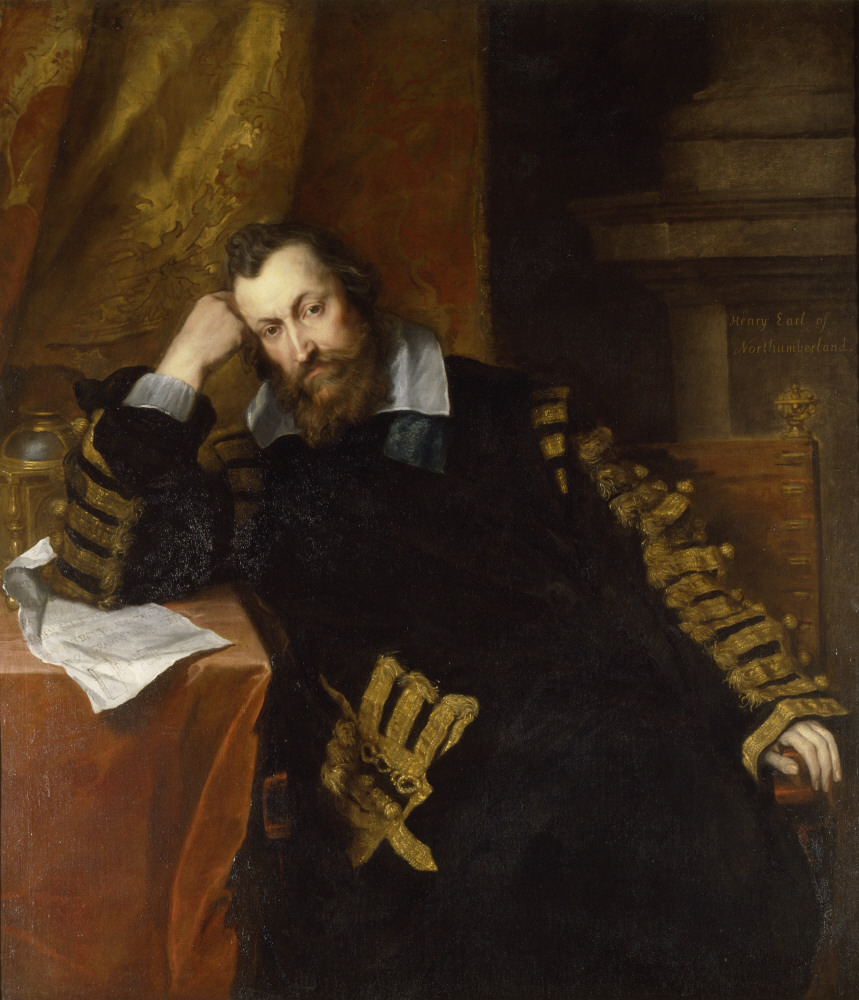
 en.wikipedia.org
en.wikipedia.org
Because of his interest in scientific experiments and his library, Northumberland acquired the nickname "The Wizard Earl". The library was one of the largest in England at the time. He was a patron to Thomas Harriot, Nicholas Hill, Robert Hues, Nathaniel Torporley and Walter Warner[15] The astrologer John Dee, nearby Syon House at Mortlake, was also a friend of Henry, and their circles overlapped.[16] Harriot had been a navigational tutor to Ralegh and his captains. From 1598 (or possibly from 1607) Harriot lived at Syon House. There he used a telescope to make a map of the moon several months before Galileo did the same. He may have been the first person to observe sunspots.
For a deeper view of things, you may wish to read:
Added: The Wizard Earl's son, Algernon, was a Parliamentarian, though he did not support the execution of the king.
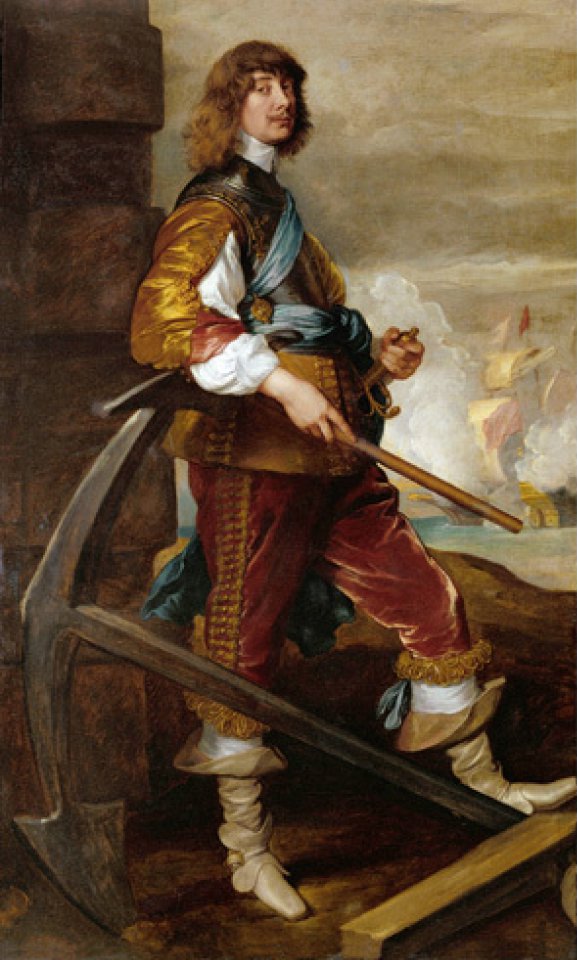
 en.wikipedia.org
en.wikipedia.org
Algernon's son, Josceline was the last male of the line:
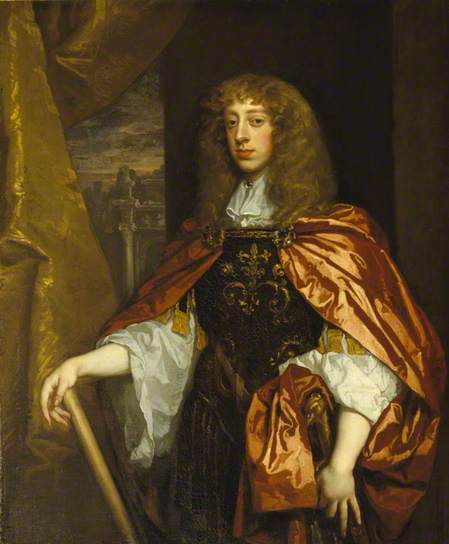
 en.wikipedia.org
en.wikipedia.org
Josceline's daughter, Elizabeth, married Charles Seymour, Duke of Somerset, who took the name Percy as part of the marriage agreement.
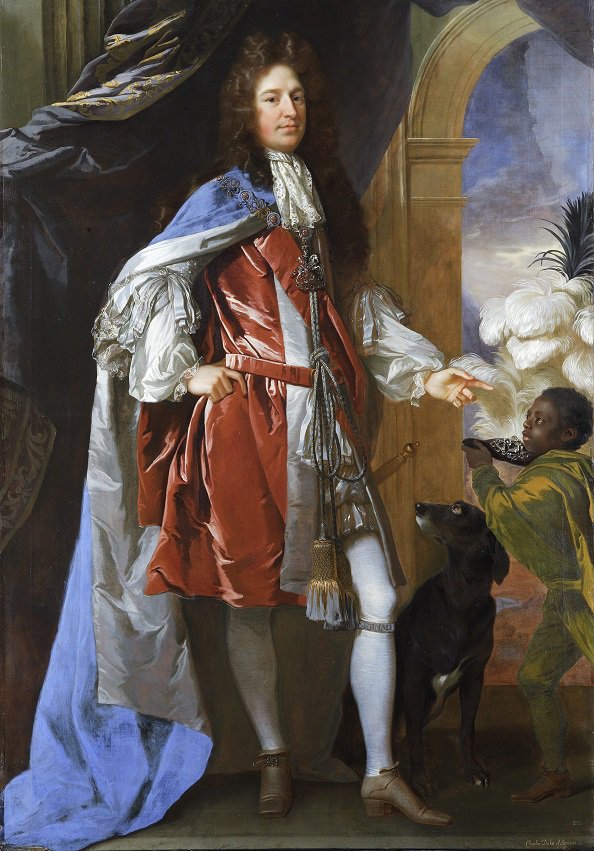
 en.wikipedia.org
en.wikipedia.org
Charles and Elizabeth had one surviving son, Algernon. Algernon married Frances Thynne.
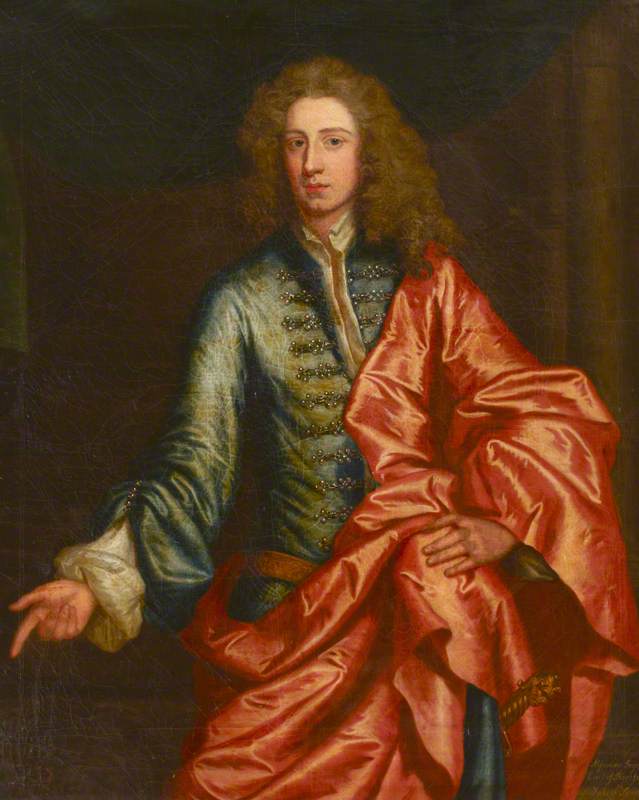
 en.wikipedia.org
en.wikipedia.org
Algernon Seymour, 7th Duke of Somerset (11 November 1684 – 7 February 1749), eldest surviving son and heir, known during his father's lifetime by the courtesy title of Earl of Hertford, one of his father's subsidiary titles. Algernon's only daughter and sole-heiress Lady Elizabeth Seymour, suo jure Baroness Percy, together with her husband Sir Hugh Smithson, 4th Baronet (died 1786) (who in 1749 adopted the surname Percy and in 1766 was created Duke of Northumberland) inherited half the great Percy estates including Alnwick Castle and Syon House.
Indeed, don't forget Syon House:
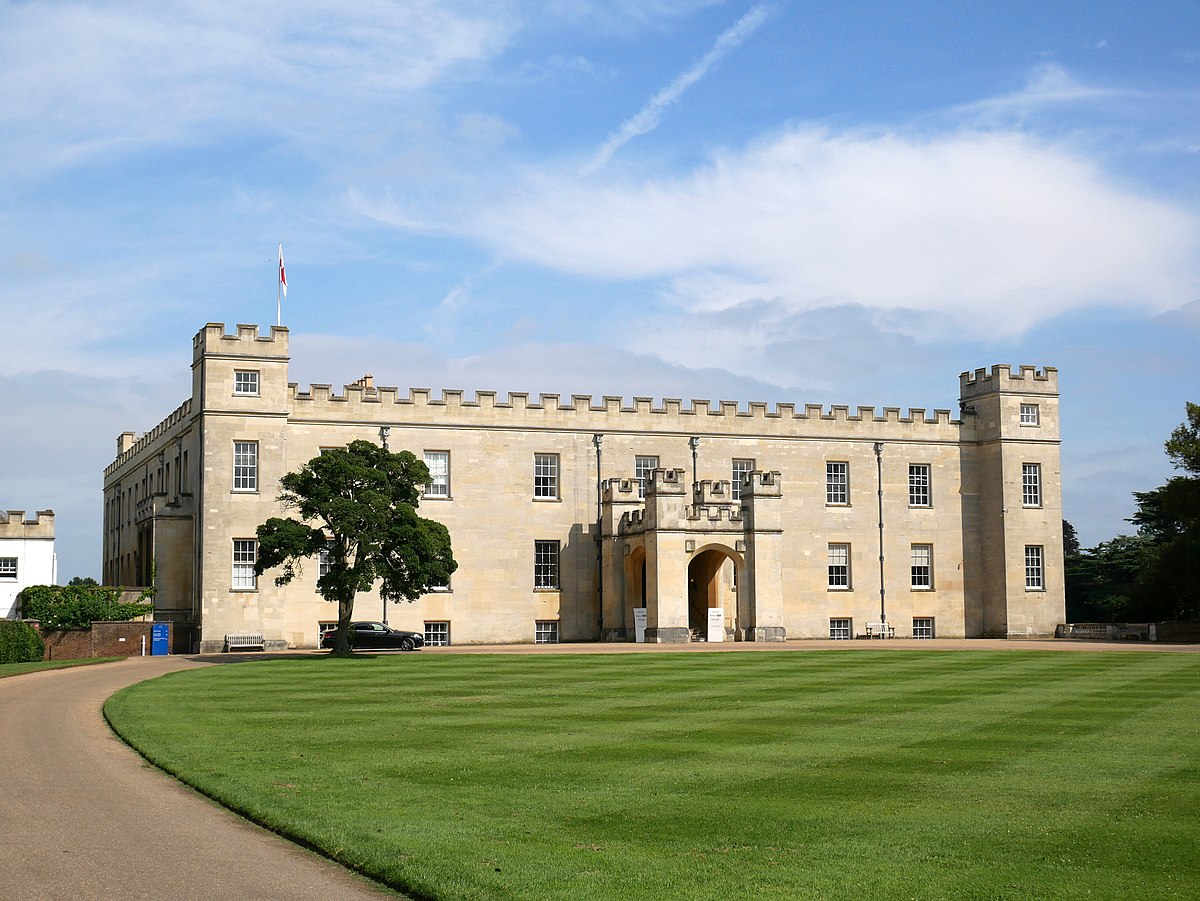
 en.wikipedia.org
en.wikipedia.org
Syon House derives its name from Syon Abbey, a medieval monastery of the Bridgettine Order, founded in 1415 on a nearby site by King Henry V. The abbey moved to the site now occupied by Syon House in 1431. It was one of the wealthiest nunneries in the country and a local legend recites that the monks of Sheen had a ley tunnel[clarification needed] running to the nunnery at Syon.[3] In 1539, the abbey was closed by royal agents during the Dissolution of the Monasteries and the monastic community was expelled.[4]
On the dissolution of the abbey, Syon became the property of the Crown for a short time before long lease to the 1st Duke of Somerset, who had the site rebuilt as Syon House in the Italian Renaissance style before his death in 1552. In 1541 and part of the following year Henry VIII's fifth wife Catherine Howard faced her long imprisonment at Syon. In February 1542, the King's men took her to the Tower of London and executed her on charges of adultery. Five years later, when King Henry VIII died, his coffin, surmounted by a jewelled effigy, rested at Syon House for one night before the procession continued to his burial place in St George's Chapel, Windsor.
Lady Jane Grey was living in the house in July 1553 with her husband when she received news that she was to become Queen.
[...]
In November 2010, the results from an archaeological dig made two years before on the site of the new hotel were reported, with the excavations uncovering the remains of a Roman village that existed in what was then the rural outskirts of Londinium. Artefacts uncovered included 11,500 pottery fragments, 100 coins and pieces of jewellery. Some of the finds remain unexplained, such as the discovery of skeletons "buried in ditches placed on their side". Although the skeletons date from the Roman period, this burial practice was said by the senior archaeologist to be "more suggestive of unknown prehistoric rites than Roman practice"

Henry Percy, 9th Earl of Northumberland - Wikipedia
Because of his interest in scientific experiments and his library, Northumberland acquired the nickname "The Wizard Earl". The library was one of the largest in England at the time. He was a patron to Thomas Harriot, Nicholas Hill, Robert Hues, Nathaniel Torporley and Walter Warner[15] The astrologer John Dee, nearby Syon House at Mortlake, was also a friend of Henry, and their circles overlapped.[16] Harriot had been a navigational tutor to Ralegh and his captains. From 1598 (or possibly from 1607) Harriot lived at Syon House. There he used a telescope to make a map of the moon several months before Galileo did the same. He may have been the first person to observe sunspots.
For a deeper view of things, you may wish to read:
Amazon.fr - The Occult Philosophy in the Elizabethan Age - Yates, Frances - Livres
Noté /5. Retrouvez The Occult Philosophy in the Elizabethan Age et des millions de livres en stock sur Amazon.fr. Achetez neuf ou d'occasion
www.amazon.fr
Added: The Wizard Earl's son, Algernon, was a Parliamentarian, though he did not support the execution of the king.

Algernon Percy, 10th Earl of Northumberland - Wikipedia
Algernon's son, Josceline was the last male of the line:

Josceline Percy, 11th Earl of Northumberland - Wikipedia
Josceline's daughter, Elizabeth, married Charles Seymour, Duke of Somerset, who took the name Percy as part of the marriage agreement.

Charles Seymour, 6th Duke of Somerset - Wikipedia
Charles and Elizabeth had one surviving son, Algernon. Algernon married Frances Thynne.

Algernon Seymour, 7th Duke of Somerset - Wikipedia
Algernon Seymour, 7th Duke of Somerset (11 November 1684 – 7 February 1749), eldest surviving son and heir, known during his father's lifetime by the courtesy title of Earl of Hertford, one of his father's subsidiary titles. Algernon's only daughter and sole-heiress Lady Elizabeth Seymour, suo jure Baroness Percy, together with her husband Sir Hugh Smithson, 4th Baronet (died 1786) (who in 1749 adopted the surname Percy and in 1766 was created Duke of Northumberland) inherited half the great Percy estates including Alnwick Castle and Syon House.
Indeed, don't forget Syon House:

Syon House - Wikipedia
Syon House derives its name from Syon Abbey, a medieval monastery of the Bridgettine Order, founded in 1415 on a nearby site by King Henry V. The abbey moved to the site now occupied by Syon House in 1431. It was one of the wealthiest nunneries in the country and a local legend recites that the monks of Sheen had a ley tunnel[clarification needed] running to the nunnery at Syon.[3] In 1539, the abbey was closed by royal agents during the Dissolution of the Monasteries and the monastic community was expelled.[4]
On the dissolution of the abbey, Syon became the property of the Crown for a short time before long lease to the 1st Duke of Somerset, who had the site rebuilt as Syon House in the Italian Renaissance style before his death in 1552. In 1541 and part of the following year Henry VIII's fifth wife Catherine Howard faced her long imprisonment at Syon. In February 1542, the King's men took her to the Tower of London and executed her on charges of adultery. Five years later, when King Henry VIII died, his coffin, surmounted by a jewelled effigy, rested at Syon House for one night before the procession continued to his burial place in St George's Chapel, Windsor.
Lady Jane Grey was living in the house in July 1553 with her husband when she received news that she was to become Queen.
[...]
In November 2010, the results from an archaeological dig made two years before on the site of the new hotel were reported, with the excavations uncovering the remains of a Roman village that existed in what was then the rural outskirts of Londinium. Artefacts uncovered included 11,500 pottery fragments, 100 coins and pieces of jewellery. Some of the finds remain unexplained, such as the discovery of skeletons "buried in ditches placed on their side". Although the skeletons date from the Roman period, this burial practice was said by the senior archaeologist to be "more suggestive of unknown prehistoric rites than Roman practice"
Last edited:
Notice that Frances Yates, in her books, ""dealt with traditions whose remoteness she could not eliminate, even while she made them more understandable."
I should add that if you really want to understand "magic" or "magick", then you should definitely read Marc van de Mieroop's book "Philosophy Before the Greeks."
Van De Mieroop uncovers Babylonian approaches to knowledge in three areas: the study of language, which in its analysis of the written word formed the basis of all logic; the art of divination, which interpreted communications between gods and humans; and the rules of law, which confirmed that royal justice was founded on truth.
I should add that if you really want to understand "magic" or "magick", then you should definitely read Marc van de Mieroop's book "Philosophy Before the Greeks."
Van De Mieroop uncovers Babylonian approaches to knowledge in three areas: the study of language, which in its analysis of the written word formed the basis of all logic; the art of divination, which interpreted communications between gods and humans; and the rules of law, which confirmed that royal justice was founded on truth.
Sorry Laura but had to post again as I think all roads are really leading back to Francis Bacon here. I am posting an extract from the 12 July 1997 session to demonstrate:Well, that's an interesting conjecture about Anne Boleyn.
I've got quite a few connections between my Percys and the Earls of Arundel in the tree, but I didn't find any Talbots except a couple more recent connections who spelled their name "Talbott".
It's all highly suggestive of something underneath, but no cigar yet.
Session 12 July 1997:
Q: Okay, in this relief painting done by Berenger Sauniere in the church at Rennes le Chateau, Mary Magdalene is depicted as gazing hopefully or reverently at a tree branch formed into a cross, stuck in the ground. What kind of tree is it?
A: The "tree of life."
Q: Well, I had a different idea... some people say it is an acacia tree. Are you saying it is not a genus, horticulturally?
A: Genus is family tree.
Q: And what family is it a family tree for?
A: Check your Magna for lesson.
Q: My magna? What in the world? Okay, "blue apples:" Stones or grapes?
A: Why not both?
Q: Okay! I can accept that! What was Berenger Sauniere collecting all those rocks for?
A: What about conductor?
Q: What do you mean?
A: What conducts.
Q: Was he building a little Stonehenge?
A: Have you researched the power of Stonehenge, and how it relates... where it fits in?
Q: Yes, we are bit by bit collecting things...
A: Well? And crop circles? Amazing connections... And what of "The Rosy Cross?"
Q: Well, this is what we are looking at! I have even discovered that Sir Francis Bacon's name is even derived from "beech," and that his Latin signature has the gematria number of 17 - and January 17 is the feast day of St. Anthony, who replaced St. Augustine in this affair somewhat... and I have connected the Rosicrucians all over the blasted planet, for crying out loud! And, who is who here? Just who are the good guys?
A: Airports are used by both.
Q: Well, what is THAT supposed to mean?
A: Transdimensional Atomic Remolecularizer.
Q: You mean there is a TDARM at the Denver Airport?
A: Not that simple... and much, much deeper meaning. Did you catch the latest report about Neanderthals and DNA and how it relates to you?
Their reference to "Magna" could mean both magnetite (with all that that conveys), as mentioned in an ealier session, and Magna Carta, relating to the charter King John signed at Runnymede for the English Barons Some historians think King John was forced to sign it by the head of the Knights Templar in England (the forerunners of the Freemasons and Rosicrucians) and therefore this links subsequently to Bacon and his Freemasons/Rosicrucians their successors. 'Magna' also means 'Work' as in 'The Great Work' (magnus opus), which was something Bacon taught of in his Rosicrucian writings (transmutation of the inner person).
Where the C's say "Airports are used by both", I think they are linking what is happening at Denver Airport with the PTB (and Lizzies) and the TDARM at Oak Island, which Francis Bacon may have played a role in burying there (see my earlier post). Remember that Bacon was part of the PTB of his own age.
It is interesting that they link Crop Circles, Stonehenge and the Rosy Cross together. We know that crop circles are messages from both 4D STS and 6D STO. Stonehenge, a Temple of Apollo, was used by the druids and the British Rosicrucians of the 16th and 17h centuries, men like Dr. John Dee and Bacon, were in one sense latter day druids who had a fondness for Arthurian legends, where one of the key figures was Merlin, a Britsh druid (some claim he came from the Isle of Man - I am researching that).
If the Rosicrucians (Illuminati) are the spider in the middle of the web, it makes sense of their subsequent quote that it is your destiny to 'pierce the spider'.
Then there is the reference to the Tree of Life and family trees, which we have been touching on in this thread including yours.
When responding to another Forum member on the 13th March thread, I menioned the subject of egregores and came upon this interesting nugget of information:
Dion Fortune
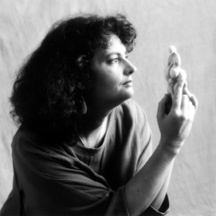
Dion Fortune
During World War II, Dion Fortune, a prominent British occultist and author, gathered her followers in Britain together for a psychic war against Germany. Her group, the Fraternity of the Inner Light, were not able to meet in person because of wartime travel restrictions but she got the word out to her group in writing. “The war has to be fought and won on the physical plane,” she wrote, “before physical manifestation can be given to the archetypal ideals. What was sown will grow and bear seed.”
Fortune invoked ancient spirits pledged to protect Britain, including King Arthur, Merlin, St. Michael and St. George. Here is a description of the process Dion Fortune followed to create the protective egregore:
The working began with the formulating of the symbol of the Rose-Cross. As this symbol was built on the astral planes each week, it developed through a series of changes in a clear sequence – a sign that the inner powers had been contacted and were responding. First, the Rose-Cross was surrounded by a golden light, then a diamond light, indicating a very high grade of power. Soon it became clear that the Rose-Cross was situated in a cavern deep beneath Glastonbury Tor. The figures of seven of the Masters then appeared around it. In later meditations, three key figures appeared: King Arthur, Merlin and the Master Jesus, later joined by the figure of the Virgin Mary, also seen as Binah and the heavenly Isis, bearing the Grail.[9]
Britain was never invaded despite the immense power of the Nazi war machine.
Curious timing I should spot this now!
I will read with interest. With regard to Henry Percy, I see that the astrologer John Dee, nearby Syon House at Mortlake, was also a friend of Henry, and their circles overlapped. That to me is very telling. Did Henry meet with Giordano Bruno I wonder, when Bruno met with Sir Philip Sydney and his circle of friends?Then, there was "The Wizard Earl."

Henry Percy, 9th Earl of Northumberland - Wikipedia
en.wikipedia.org
Because of his interest in scientific experiments and his library, Northumberland acquired the nickname "The Wizard Earl". The library was one of the largest in England at the time. He was a patron to Thomas Harriot, Nicholas Hill, Robert Hues, Nathaniel Torporley and Walter Warner[15] The astrologer John Dee, nearby Syon House at Mortlake, was also a friend of Henry, and their circles overlapped.[16] Harriot had been a navigational tutor to Ralegh and his captains. From 1598 (or possibly from 1607) Harriot lived at Syon House. There he used a telescope to make a map of the moon several months before Galileo did the same. He may have been the first person to observe sunspots.
For a deeper view of things, you may wish to read:
Amazon.fr - The Occult Philosophy in the Elizabethan Age - Yates, Frances - Livres
Noté /5. Retrouvez The Occult Philosophy in the Elizabethan Age et des millions de livres en stock sur Amazon.fr. Achetez neuf ou d'occasionwww.amazon.fr
Added: The Wizard Earl's son, Algernon, was a Parliamentarian, though he did not support the execution of the king.

Algernon Percy, 10th Earl of Northumberland - Wikipedia
en.wikipedia.org
Algernon's son, Josceline was the last male of the line:

Josceline Percy, 11th Earl of Northumberland - Wikipedia
en.wikipedia.org
Josceline's daughter, Elizabeth, married Charles Seymour, Duke of Somerset, who took the name Percy as part of the marriage agreement.

Charles Seymour, 6th Duke of Somerset - Wikipedia
en.wikipedia.org
Charles and Elizabeth had one surviving son, Algernon. Algernon married Frances Thynne.

Algernon Seymour, 7th Duke of Somerset - Wikipedia
en.wikipedia.org
Algernon Seymour, 7th Duke of Somerset (11 November 1684 – 7 February 1749), eldest surviving son and heir, known during his father's lifetime by the courtesy title of Earl of Hertford, one of his father's subsidiary titles. Algernon's only daughter and sole-heiress Lady Elizabeth Seymour, suo jure Baroness Percy, together with her husband Sir Hugh Smithson, 4th Baronet (died 1786) (who in 1749 adopted the surname Percy and in 1766 was created Duke of Northumberland) inherited half the great Percy estates including Alnwick Castle and Syon House.
Indeed, don't forget Syon House:

Syon House - Wikipedia
en.wikipedia.org
Syon House derives its name from Syon Abbey, a medieval monastery of the Bridgettine Order, founded in 1415 on a nearby site by King Henry V. The abbey moved to the site now occupied by Syon House in 1431. It was one of the wealthiest nunneries in the country and a local legend recites that the monks of Sheen had a ley tunnel[clarification needed] running to the nunnery at Syon.[3] In 1539, the abbey was closed by royal agents during the Dissolution of the Monasteries and the monastic community was expelled.[4]
On the dissolution of the abbey, Syon became the property of the Crown for a short time before long lease to the 1st Duke of Somerset, who had the site rebuilt as Syon House in the Italian Renaissance style before his death in 1552. In 1541 and part of the following year Henry VIII's fifth wife Catherine Howard faced her long imprisonment at Syon. In February 1542, the King's men took her to the Tower of London and executed her on charges of adultery. Five years later, when King Henry VIII died, his coffin, surmounted by a jewelled effigy, rested at Syon House for one night before the procession continued to his burial place in St George's Chapel, Windsor.
Lady Jane Grey was living in the house in July 1553 with her husband when she received news that she was to become Queen.
[...]
In November 2010, the results from an archaeological dig made two years before on the site of the new hotel were reported, with the excavations uncovering the remains of a Roman village that existed in what was then the rural outskirts of Londinium. Artefacts uncovered included 11,500 pottery fragments, 100 coins and pieces of jewellery. Some of the finds remain unexplained, such as the discovery of skeletons "buried in ditches placed on their side". Although the skeletons date from the Roman period, this burial practice was said by the senior archaeologist to be "more suggestive of unknown prehistoric rites than Roman practice"

Philip Sidney - Wikipedia
If I am simply overlapping work you have already done, please let me know since I do not wish to duplicate effort when time is precious.
